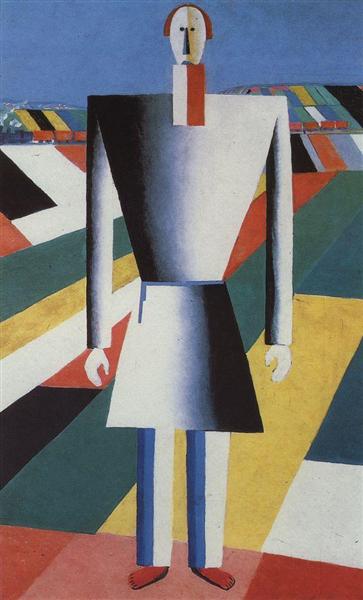Description
Kazimir Malevich is mainly known for its fundamental role in the development of suprematism, a stream of abstract art that sought to transmit purity and essence through geometric shapes and flat colors. However, his painting "peasant in the field" of 1929 represents a later stage in his career where, without abandoning abstraction, he introduces figurative elements and a symbolism that resonates with the social and political tensions of his time.
In this work, Malevich presents a human figure in the middle of a rural landscape. The figure of the peasant, highlighting in the foreground, has no face, a recurring feature in some of the works of Malevich of this era. This omission of the face can be interpreted as a comment on dehumanization and loss of individual identity in a period of profound economic and social changes in the Soviet Union. The figure stands in a firm posture, in an act of resistance or constant work, thus encapsulating the hard and monotonous life of the peasantry.
The landscape is, in itself, an abstraction of geometric characteristics. The fields extend in straight lines and colors that vary between deep terrible and green tones, suggesting a stylized interpretation of the cultivated land. Malevich uses different color planes to add depth and perspective to painting, but does it without giving up the flatness inherent in its suprematist style.
The colors used, mainly ocher, green and blue, create a contrast that, although simplistic, is evocative. There is no lush variety of tones, but rather a restricted palette that underlines the austere life of the peasant. The deep blue of heaven adds serenity and immensity that contrasts with the rigidity and monotony of the lines that represent the fields, at the same time evoking a sensation of infinity and confinement.
"Peasant in the countryside" can also be seen as an intersection between art and politics. During the 1920s, Malevich distanced himself from purely abstract approaches and began to reintroduce figurative elements in his work, possibly in response to the policies of the Soviet Union that privileged socialist realism. However, he never completely abandoned his abstract roots, and this is reflected in his treatment of the human figure and the landscape.
He painting He relates and contrasts to other works by Malevich, such as his famous "Campesino Head" (1928-29), which also lacks facial features and carries a similar clothing. This repetition of issues and concepts underlines its constant concern for the situation of the peasantry in the Soviet Russia, using the way to comment on the social function and structural changes of the time.
In "Peasant in the countryside", Kazimir Malevich offers us a window to the soul and the routine of the Russian farmer, while continuing to explore the possibilities of geometric abstraction. Its use of color, shape and composition not only serves to visually delight, but also to invite a deeper reflection on identity, resistance and human condition in a world of constant change. Thus, this work stands as one of the significant pieces of its artistic transition and its social commitment.
KUADROS ©, a famous paint on your wall.
Hand-made oil painting reproductions, with the quality of professional artists and the distinctive seal of KUADROS ©.
Art reproduction service with satisfaction guarantee. If you are not completely satisfied with the replica of your painting, we refund your money 100%.

